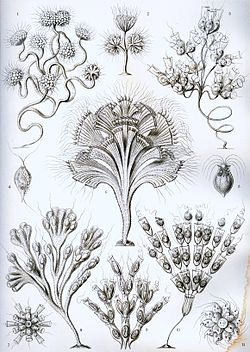| Phalansterium | |
|---|---|
 | |
| Phalansterium digitatum (figure 8) | |
| Scientific classification | |
| Domain: | |
| (unranked): | |
| Subphylum: | |
| Class: | |
| Order: | Hibberd, 1983 |
| Family: | Kent, 1880-1881 |
| Genus: | Phalansterium Cienkowski, 1870 |
Phalansterium is a genus of single-celled flagellated organisms comprising several species, which form colonies. [1] Phalansterium produces tetraspores. [2]
Phalansterium is hard to classify; it has a distinctive ultrastructure of its pericentriolar material. Molecular evidence places it in the Amoebozoa. [3] [4]
It has been suggested that it is similar to the ancestral eukaryote. [5]